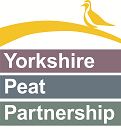Male white-faced darter © Vicky Fletcher
Dragons in the Dales
Since the 19th century, the extent of active lowland raised bog in the UK has declined by 94%, and with it the prime breeding habitat for dragonflies such as the white-faced darter (Leucorrhinia dubia), which is red-listed. The female lays her eggs in floating rafts of Sphagnum cuspidatum in bog pools, where the larvae then spend 2 years in the acidic waters safe from predators like fish.
Yorkshire Peat Partnership is working to research the habitat requirements of the white-faced darter and to restore dragonfly habitats in Yorkshire peatlands. Our project ‘Dragons in the Dales’, funded by Natural England’s Species Recovery Programme, hopes to increase this species’ range, and return these beautiful creatures to Yorkshire.
Female white-face darter © Vicky Fletcher
In the first phase of the project, we are focusing on Swarth Moor SSSI, a nationally significant lowland raised bog on the edge of the Ingleborough National Nature Reserve, just 4 miles outside Settle. We are working with local landowners and stakeholders to restore and enhance the dragonfly habitat on this site. We also aim to engage local community groups and schools with the lowland peat bogs and charismatic dragonflies on their doorstep.
The first UK record for the white-faced darter was here in Yorkshire in 1837; however, this species hasn’t been seen in Yorkshire since the 1950s. In fact, we have identified a data gap in dragonflies on our peaty sites – so we are setting up a dragonfly survey transect to begin to fill that gap, with the help of a team of volunteers.
In preparation for the reintroduction work, we are researching the known habitat requirements of the white-faced darter. This will allow us to run computational models of the current and future habitat range of this species, and this in turn will enable us to identify suitable receptor sites for future translocations.
Once we have identified suitable receptor sites and donor populations, we will seek further funding to reintroduce the white-faced darter to Yorkshire.



